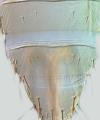Thrips flavus
Recognition data
Distinguishing features
Both sexes fully winged. Body and legs yellow, major setae light brown; antennal segments IV–V brown distally, VI–VII brown; fore wings pale. Head wider than long; two pairs of ocellar setae; pair III small, arising within the ocellar triangle behind the first ocellus; postocular setae pair I slightly longer than ocellar setae III. Antennae 7-segmented; segments III–IV with short forked sensorium; VII short. Pronotum with 2 pairs of long posteroangular setae; posterior margin with 3 pairs of setae. Metanotum with irregular longitudinal lines converging to posterior margin, at anterior with curving transverse lines; median setae arising behind anterior margin; campaniform sensilla present. Fore wing first vein with 3 (sometimes 2) setae on distal half; second vein with row of about 15 setae. Abdominal tergite II with 4 lateral marginal setae; tergites V–VIII with paired ctenidia laterally, on VIII posteromesad to spiracles; tergite VIII posteromarginal comb complete, microtrichia long and slender; pleurotergites without discal setae. Sternite II with 2 pairs of marginal setae, III–VII with 3 pairs; sternites without discal setae.
Male smaller than female; tergite VIII with marginal comb complete medially; sternites III–VII with narrow transverse pore plate.
Related and similar species
This species is remarkably similar in structure to the tropical pest, T. palmi, but has ocellar setae III arising inside the ocellar triangle behind the first ocellus. The genus Thrips is the second largest genus in the Thysanoptera, and currently includes, worldwide, about 285 species. All members of genus Thrips lack ocellar setae I on the head, and they all have ctenidia on tergite VIII posteromesad to the spiracles. Other characters, such as number of antennal segments, number of setae on the fore wing veins, and number of discal setae on the sternites are variable between species (Palmer, 1992; Nakahara, 1994; Mound & Masumoto, 2005).
Taxonomic data
Current valid name
Thrips flavus Schrank
Original name and synonyms
- Thrips flavus Schrank, 1776: 31
- Thrips melanopa Schrank, 1776: 31
- Thrips ochraceus Curtis, 1841:228
- Physothrips flavidus Bagnall, 1916: 399
- Thrips flavidus Bagnall, 1916: 402
- Thrips flavosetosus Priesner, 1919: 105
- Thrips obscuricornis Priesner, 1927: 423
- Physothrips flavus Bagnall, 1928: 98
- Taeniothrips clarus Moulton, 1928: 287
- Thrips kyotoi Moulton, 1928: 302
- Thrips nilgiriensis Ramakrishna, 1928: 262
- Taeniothrips luteus Oettingen, 1935: 183
- Taeniothrips sufuratus Priesner, 1935: 358
- Thrips biarticulata Priesner, 1935: 358
- Taeniothrips saussureae Ishida, 1936: 70
- Taeniothrips rhopalantennalis Shumsher, 1946: 181
Family placement
Thripidae, Thripinae
Common names
European flower thrips
Biological data
Life history
Breeding in flowers and on leaves.
Host plants
Apparently highly polyphagous.
Tospoviruses vectored
Reports are conflicting, mainly because of confusion with T. palmi.
Crop damage
Not usually regarded as a serious pest species.
Distribution data
Area of origin
Eurasia
Distribution
Widespread across Eurasia from Britain to China, Japan and Taiwan, but not recorded from any part of North America (Nakahara, 1994); included here for quarantine detection convenience in California.






